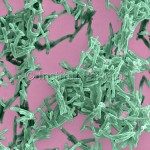Link to Pubmed [PMID] – 12930144
J. Med. Chem. 2003 Aug;46(18):3811-21
Thymidine monophosphate kinase (TMPK) of Mycobacterium tuberculosis (TMPKmt) represents an attractive target for blocking the bacterial DNA synthesis. In an attempt to find high-affinity inhibitors of TMPKmt, a cavity in the enzyme at the 3′-position was explored via the introduction of various substituents at the 3′-position of the thymidine monophosphate (dTMP) scaffold. Various 3′-C-branched chain substituted nucleotides in the 2′-deoxyribo (3-6) and ribo series (7, 8) were synthesized from one key intermediate (23). 2′-Deoxy analogues proved to be potent inhibitors of TMPKmt: 3′-CH(2)NH(2) (4), 3′-CH(2)N(3) (3), and 3′-CH(2)F (5) nucleotides exhibit the highest affinities within this series, with K(i) values of 10.5, 12, and 15 microM, respectively. These results show that TMPKmt tolerates the introduction of sterically demanding substituents at the 3′-position. Ribo analogues experience a significant affinity decrease, which is probably due to steric hindrance of Tyr103 in close vicinity of the 2′-position. Although the 5′-O-phosphorylated compounds have somewhat higher affinities for the enzyme, the parent nucleosides generally exhibit affinities for TMPKmt in the same order of magnitude and display a superior selectivity profile versus human TMPK. This series of inhibitors holds promise for the development of a new class of antituberculosis agents.



